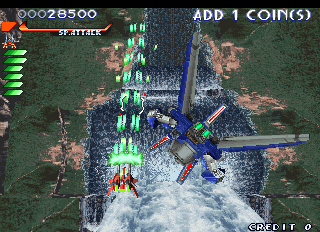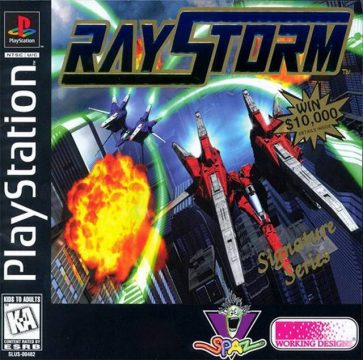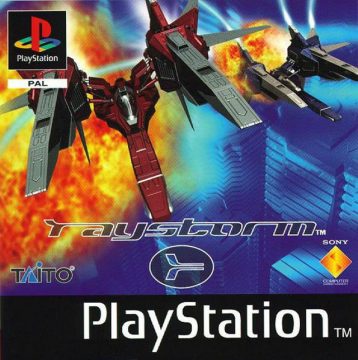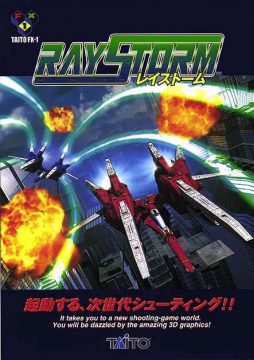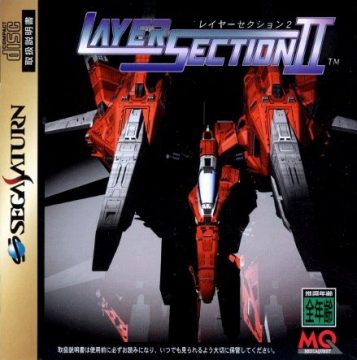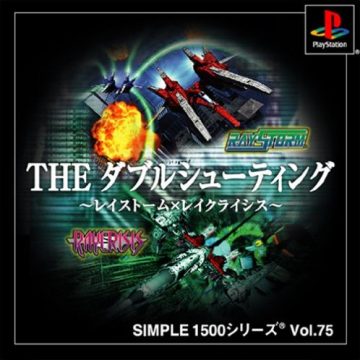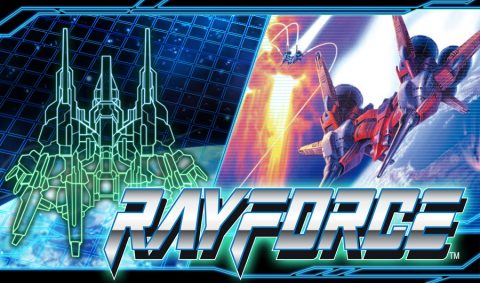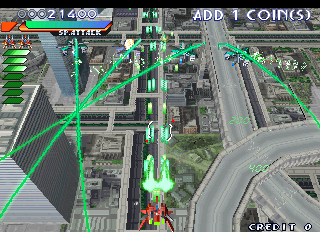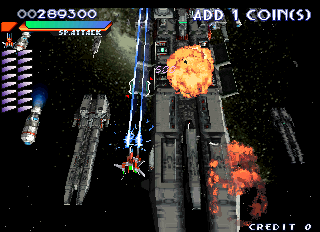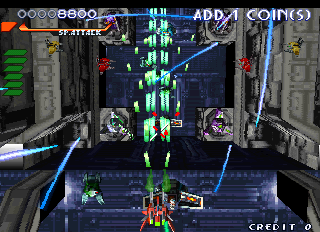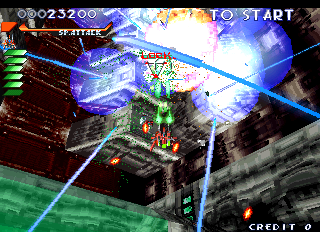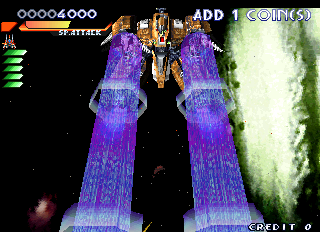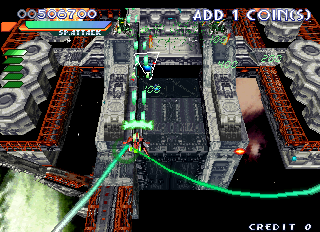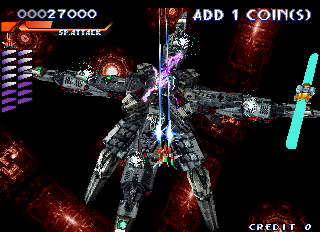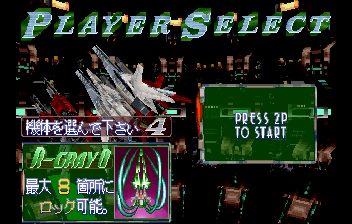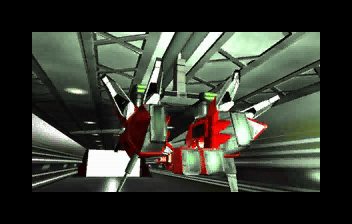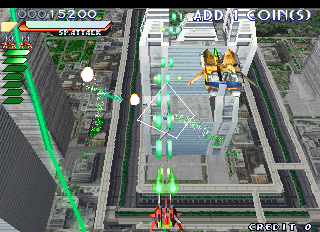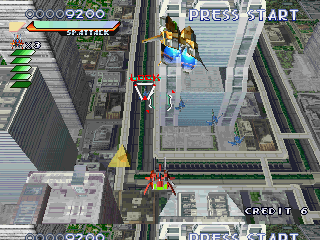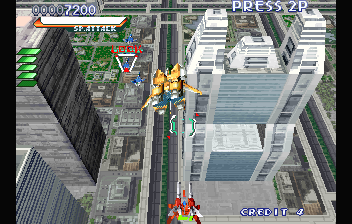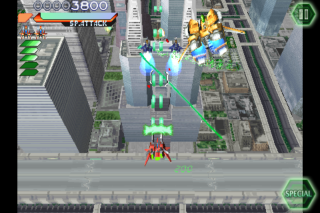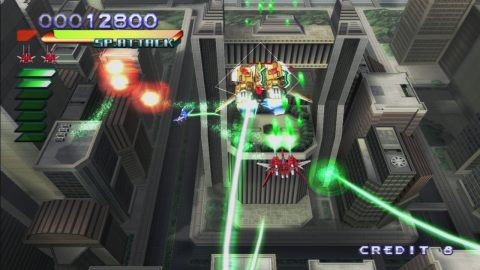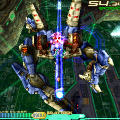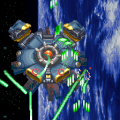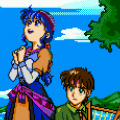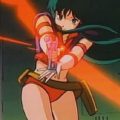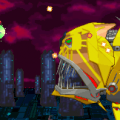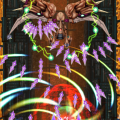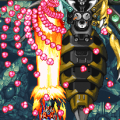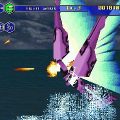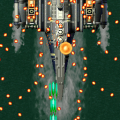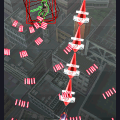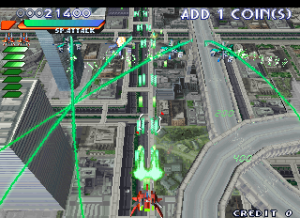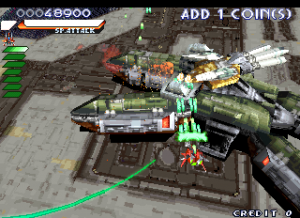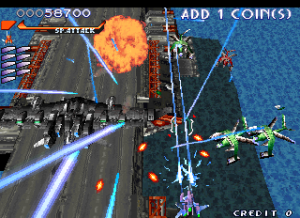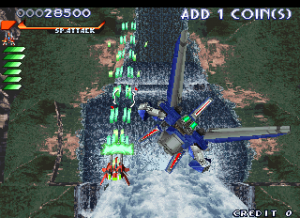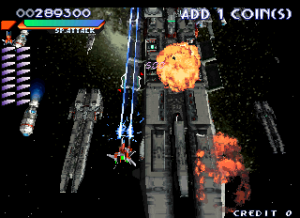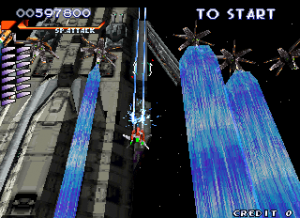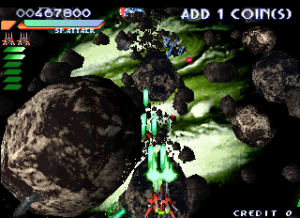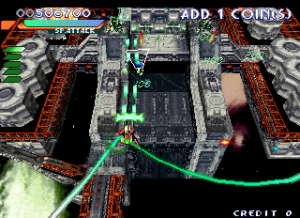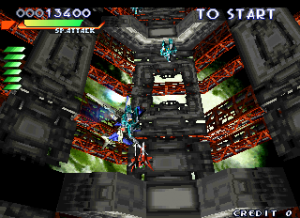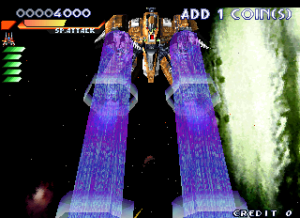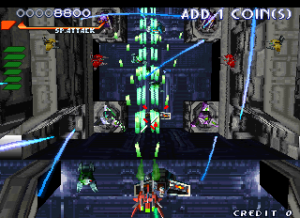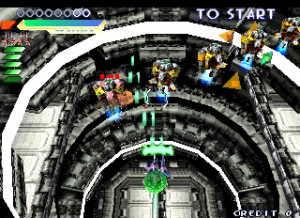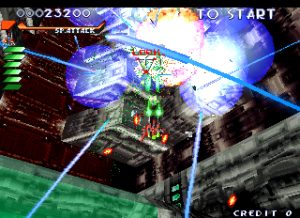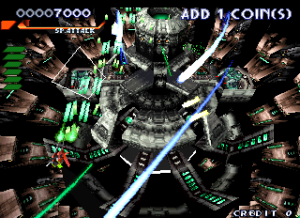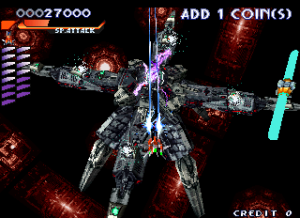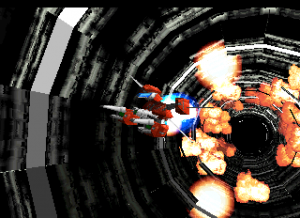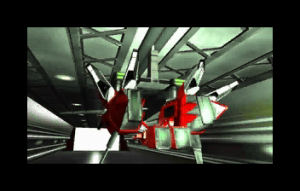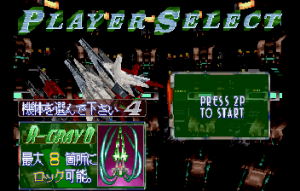With the considerably high amount of quality that went into RayForce, it was just too good to let fade away into arcade obscurity. Thankfully, a sequel was indeed conjured to preserve the Ray- prefix in the form of RayStorm, and while not quite as awesome as its forefather, it nonetheless stands as a venerable example of what a space shoot-em-up embodies. However, there’s a possibility it may not even take place in the same continuity as the first game, as humanity was nearly obliterated in RayForce and the Earth irreversibly corrupted by science gone wrong.
In RayStorm, Earth is doing well and humanity has prospered enough to expand space colonies all the way into Orion. Either RayStorm takes place in a different continuity and is primarily a sequel in name only, or humankind REALLY bounced back from being reduced to a mere 0.02% of its former self. Anyway, the important thing is that the year is 2219 and the rebellious colony of Secilia successfully overthrows the government of the Earth-based Star Federation (which may or may not be a nod to Star Trek). However, Selicia intends to obliterate the earth and all the people on it, good or bad. To counter the looming rebel army threat, Earth sends out a covertly-developed fighter codenamed the R-Gray in hopes of penetrating the Secilian atmosphere and obliterating Secilia’s base of operations, the Juda Central Core.
The plot is more so what you’d expect of shoot-em-ups as opposed to RayForce‘s “Skynet” setup, but even if it’s not as engaging, it is essentially gravy to what you’re seeing on the screen. You do get a note of when and where you start out each level, but other than that, all you need to know is that you’ve got a lot of polygonal enemy machines to blow apart. RayStorm runs on Taito’s rarely-used FX-1B graphical processor (same hardware as G-Darius), rendering everything in full-on 3D. Admittedly, it has not aged quite as well as the brighter and smoother sprite-based visuals of RayForce, though it’s certainly not ugly for what is essentially early PlayStation technology. Although the viewpoint is still overhead, it now features a horizontally oriented playfield, rather than the vertically oriented one of its predecessor. In that sense, it’s somewhat similar to Game Arts’ classic PC / Sega CD shooter Silpheed.
The neat touch of level continuity is missing here also; you just pop up into the next stage after each fallen boss, making RayStorm feel a bit less immersive. All that said, the game still looks quite presentable and the action runs at a smooth rate, with the bosses looking particularly impressive as expected. The music is also much the same as the graphics; quite good but not as good alongside its predecessor. The first stage’s track, “Geometric City,” may as well be a remix of “Penetration,” which isn’t a fault against it as it’s still pretty groovy. There’s nothing catchy you’ll be humming, but nothing feels out of place or inappropriate all the same.
While the aesthetics are arguably a bit less memorable than its predecessor, RayStorm still delivers the goods in the gameplay department. This time around, there are two fighter models up for play, with the R-Gray 1 functioning very much like the classic RVA-818 X-LAY. Its primary shot is a powerful fast-firing vulcan with a decent spread, and its secondary lock-on attack fires out strong lasers which burst on enemy contact. The new R-Gray 2 is harder to wield but arguably more powerful if you know what you’re doing with it. Its main guy is a constant laser stream which cuts through enemies harder than the R-Gray 1’s cannon, but its spread is very narrow and requires more precise aim. The secondary lock-on attack fires out electrical bolts which linger around their targets for a bit before dissipating. Each individual bolt hurts less than the R-Gray 1’s lasers, but you can have twice as many bolts as you can lasers, starting with ten and maxing out at a total sixteen potential lock-on targets.
The R-Gray 2 exhibits a higher point yield than its easier counterpart but can be harder to work with, yet it serves as the likelier candidate for shooter veterans looking to score higher with a trickier ship. You also get the option to go with “manual” or “auto” lock-on aim for either ship, where the latter choice assigns the lock-on fire to the same button as the primary fire. Manual is generally recommended for those who wish to score higher points.
Whichever ship you choose, the weapon system is akin to the first game with a few notable enhancements. Red diamond pick-ups can boost your main weapon power if you pick up three of them, and snagging a single yellow one also bolsters your central weapon. Green diamonds add one more laser to your potential lock-on maximum, and unlike RayForce, an enemy doesn’t have to be below you in order to lock on them, further boosting the use and priority of the lasers. If you’re incredibly lucky, you’ll destroy an enemy to find a sparkly blue star that instantly maxes out your power; however, if you’re not so lucky, you’ll get it the way it normally appears, which is when you continue and the game offers it to retain your power level.
The R-Grays also have two additional super-powerful attacks in their favor, one of which involves concentrating all lock-on targets upon a single enemy. The resulting “Hyper Laser” does massive damage to the target, so it is a good thing to bust out if you find an enemy that is big enough to support this attack. The other new addition is the “Special Attack,” where pressing both buttons simultaneously triggers a screen-wiping blue laser barrage which evaporates smaller enemies and does big damage to larger ones in addition to granting a few seconds of invincibility. The special meter starts out full with each new life, and after each use, it can be built up by destroying as many enemies as you possibly can.
Aside from all these enhancements, RayStorm plays very much like its forefather, even if not quite as solid. The move up to 3D admittedly works against your advantage at times, as the perspective occasionally changes around instead of staying overhead vertical as did RayForce. The definition between “front” and “below” is not always quite as clear as in RayForce, and enemy fire can be a bit harder to make out against the sharply-rendered backgrounds. The game difficulty overall feels a dash rougher, perhaps to compensate for the Special Attack invincibility, and it feels a tad cheaper in barraging you with enemies and bullets at points.
While the difficulty is not balanced as well, RayStorm isn’t steep enough to put off any shooter novices, and shmup veterans should be able to gain respectable scores, particularly if they take advantage of the new Hyper Laser. Still, the bosses can be pretty daunting, and they’re just as neat as ever to boot. The fast-rolling spider mech in the first level gives you a good idea of what to expect, and some of the later stage highlights include the badass Star Destroyer-like battleship of the fourth level and the giant R-Gray mockery in the sixth stage, complete with two assisting satellites (why don’t you get to use those?!).
There exists a video of a prototype for a potential RayForce sequel by the name of R-Gear, showing off gameplay and a 2D visual style very similar to RayForce. The fighter ship uses lock-on lasers like the R-Gray 2’s thunderbolts and fights a spider mech somewhat akin to RayStorm‘s first boss. It is more than likely that this game eventually evolved into what would become RayStorm, but whether or not R-Gear would have been more stellar than RayStorm (or even RayForce) is a purely academic sentiment. RayStorm is a damn good shoot-em-up as it stands, even if a notch below its older brother.
RayStorm is perhaps the best known of the series by virtue of having the most home ports. It received translations to the Playstation and the Saturn in 1997, one year after the initial arcade release. Since the PlayStation uses nearly identical hardware to the FX-1B, it’s almost a graphically perfect port, with only minor, insignificant downgrades to the texture quality.
It also has a new “Extra Mode” separate from the classic Arcade Mode, though it’s not too radical a change; the enemy waves are different (mostly, there are more enemies in general), the bosses are a bit tougher, and the stages take place at different times of day, so their palettes are different. There’s also an option for a remixed soundtrack dubbed the “Tanz Mix”.
In all modes, you can adjust difficulty as need be, and in an interesting touch not found in most other shooters, you are able to adjust each individual level’s difficulty allowing for some degree of challenge customization. A hidden ship can be found for play: The R-Gray 0 prototype, which functions like a faster but less powerful version of the R-Gray 1, and is perhaps similar to the X-LAY from RayForce.
There is a super-difficult “13 Ship Mode”. Not only do you get a mere 13 lives and no continues, but your ship shifts every three times you die, starting from the R-Gray 1 in manual, going to the R-Gray 2 in manual after three lives, then cycling through the auto versions of both ships before having your last ship as the R-Gray 0 prototype.
The PlayStation port was localized and published in North America by Working Designs under their Spaz label. It adds a stats tracking screen, due to a contest run by the company offering a $10,000 prize for showing off their shooter skills. It also stops the game after stage 4 if you’re playing beneath the level 4 difficulty (normal) difficulty setting, in order to curb what they term the “disposable shooter” syndrome. Therefore, the earlier difficulty settings are essentially just training modes. There’s also a budget re-release Simple 1500 Series Vol. 75: The Double Shooting: RayStorm x RayCrisis re-release, which is missing the Tanz Mix soundtrack.
Meanwhile, the Saturn version was named Layer Section II, to match with its predecessor. It was published by MediaQuest. The visuals are comparable to the PlayStation version, but with some slightly weaker textures, meshes in the place of transparencies, and more slowdown. Perhaps to make up for it, there are some prerendered cutscenes between stages, but they aren’t particularly impressive. It’s missing most of the bonus features from the PlayStation version. The arranged soundtrack is missing, though the arcade music is on the disc as redbook audio, and a handful of tracks have new versions. Plus, the “Extra Mode” features are gone, replaced with an “Attack Mode”, which is really just a score attack mode. As an addition, the R-Gray 0 ship is available during regular gameplay by default. Overall, this is definitely a case where the PlayStation version is superior.
The home console bonus features come along with the Windows port, published in 2001 in Japan by Cyberfront, which is more or less the same as the PlayStation version, though it runs at a higher resolution for crisper graphics. Several years later, the arcade version was straight ported to the PS2 version of Taito Legends 2 (ironically, not alongside RayForce, only available on the Xbox and PC versions). This is basically the same as the PlayStation version, though it only features the “Arcade Mode”, and is actually a native port for the system, rather than an emulation like most of the other games on the release.
RayStorm HD was released for both the XBOX 360 and the Playstation 3 in 2010. The PlayStation 3 version is only available in Japan, but these versions are essentially identical. The view has been expanded to a widescreen 16:9 ratio, and the graphics have been enhanced with new textures and crisper graphics, though they end up looking a bit darker. Some other parts have been tweaked, like the bullet colors in a few stages, in order to make them stand out from the background more.
It retains the Extra Mode, arranged soundtrack and customization options. The R-Gray 0 is present too, and now looks more like the X-LAY from the previous game instead of a recolored R-Gray 1, but it even adds a fourth ship named the R-Gear, the same name of the abandoned prototype sequel to RayForce. Interestingly enough, it looks like a normal-sized version of the sixth boss, including two satellites whose lasers act as lock-on attacks while the main ship fires out a stream of missiles with semi-homing ability. While the graphical touch-ups and the new fighter seem a bit paltry to an update for a game more than a decade old, it still is better than just lazily porting the home console versions straight up and make it the definitive and most easily accessible version of the game.
The iOS port, released in 2012, offers a similar control method to the port of RayStorm, where you control your ship by dragging. You can set the movement speed on the options screen, which makes it much smoother overall. In addition to an “Arcade Mode”, there is also an “iPhone Mode” that’s supposed to be optimized for smartphone play, it’s actually just the same as the “Extra Mode” (with the arranged soundtrack) from the PlayStation port, with a lower level of difficulty. Otherwise, they control identically. The visuals are better than the arcade and 32-bit console ports, but only because they run at a higher resolution. They are missing the redone visuals for the HD releases, and it still runs in 4:3. Other than the level select, it’s also missing most of the other options and additions from the 32-bit versions. However, it runs much, much better than the iOS version of RayForce, with smooth 60 FPS versions and rarely any slowdown.
